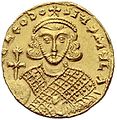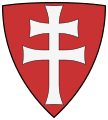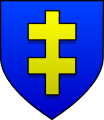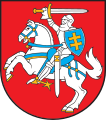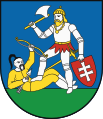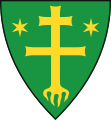
A saltire, also called Saint Andrew's Cross or the crux decussata, is a heraldic symbol in the form of a diagonal cross. The word comes from the Middle French sautoir, Medieval Latin saltatoria ("stirrup").

Ruthenian and Ruthene are exonyms of Latin origin, formerly used in Eastern and Central Europe as common ethnonyms for East Slavs, particularly during the late medieval and early modern periods. The Latin term Rutheni was used in medieval sources to describe all Eastern Slavs of the Grand Duchy of Lithuania, as an exonym for people of the former Kievan Rus', thus including ancestors of the modern Belarusians, Rusyns and Ukrainians. The use of Ruthenian and related exonyms continued through the early modern period, developing several distinctive meanings, both in terms of their regional scopes and additional religious connotations.

The Cross of Lorraine, known as the Cross of Anjou in the 16th century, is a heraldic two-barred cross, consisting of a vertical line crossed by two shorter horizontal bars. In most renditions, the horizontal bars are "graded" with the upper bar being the shorter, though variations with the bars of equal length are also seen. The Lorraine name has come to signify several cross variations, including the Patriarchal cross with its bars near the top. The Cross of Lorraine came to the Duchy of Lorraine via the Kingdom of Hungary in the 15th century. Similar two-barred cross symbols prominently feature in heraldry from Poland, Lithuania and Belarus. Its ultimate origins are theorised to be Byzantine. The Cross of Lorraine was used as a symbol of Free France during World War II and was earlier used by French patriots to signify desire to reclaim provinces lost to Germany in the Franco-Prussian War.

The national emblem of Belarus features a ribbon in the colors of the national flag, a silhouette of Belarus, wheat ears and a red star. It is sometimes referred to as the coat of arms of Belarus, although in heraldic terms this is inaccurate as the emblem does not respect the rules of conventional heraldry. The emblem is an allusion to one that was used by the Byelorussian SSR, designed by Ivan Dubasov in 1950, with the biggest change being a replacement of the Communist hammer and sickle with a silhouette of Belarus. The Belarusian name is Dziaržaŭny hierb Respubliki Biełaruś, and the name in Russian is Gosudarstvennyĭ gerb Respubliki Belarusʹ.

The national flag of Lithuania consists of a horizontal tricolour of yellow, green, and red. It was adopted on 25 April 1918 during Lithuania's first period of independence from 1918 to 1940, which ceased with the occupation first by the Soviet Union, and then by Nazi Germany (1941–1944). During the post-World War II Soviet occupation, from 1945 until 1988, the Soviet Lithuanian flag consisted first of a generic red Soviet flag with the name of the republic, in 1953 that was changed to the red flag with white and green bands at the bottom.

The coat of arms of Lithuania is a mounted armoured knight holding a sword and shield, known as Vytis. Since the early 15th century, it has been Lithuania's official coat of arms and is one of the oldest European coats of arms. It is also known by other names in various languages, such as Waykimas, Pagaunė in the Lithuanian language or as Pogonia, Pogoń, Пагоня in the Polish, and Belarusian languages. Vytis is translatable as Chase, Pursuer, Knight or Horseman, similar to the Slavic vityaz. Historically – raitas senovės karžygys or in heraldry – raitas valdovas.

The Holy Crown of Hungary, also known as the Crown of Saint Stephen, named in honour of Saint Stephen I of Hungary, was the coronation crown used by the Kingdom of Hungary for most of its existence; kings were crowned with it since the twelfth century. The Crown symbolized the King's authority over the Lands of the Hungarian Crown, and it was a key mark of legitimacy. Through the history of Hungary, more than fifty kings were crowned with it, with the last being Charles IV in 1916. The only kings not so crowned were Wladyslaw I, John Sigismund Zápolya, and Joseph II.

The coat of arms of Russia derives from the earlier coat of arms of the Russian Empire. Though modified more than once since the reign of Ivan III (1462–1505), the current coat of arms is directly derived from its medieval original, with the double-headed eagle having Byzantine and earlier antecedents. The general tincture corresponds to the fifteenth-century standard.

The Columns of Gediminas or Pillars of Gediminas are one of the earliest symbols of Lithuania and its historical coats of arms. They were used in the Grand Duchy of Lithuania, initially as a rulers' personal insignia, a state symbol, and later as a part of heraldic signs of leading aristocracy.

The globus cruciger, also known as stavroforos sphaira or "the orb and cross", is an orb surmounted by a cross. It has been a Christian symbol of authority since the Middle Ages, used on coins, in iconography, and with a sceptre as royal regalia.

The double-headed eagle is an iconographic symbol originating in the Bronze Age. A heraldic charge, it is used with the concept of an empire. Most modern uses of the emblem are directly or indirectly associated with its use by the late Byzantine Empire, originally a dynastic emblem of the Palaiologoi. It was adopted during the Late Medieval to Early Modern period in the Holy Roman Empire, Albania and in Orthodox principalities, representing an augmentation of the (single-headed) eagle or Aquila associated with the Roman Empire. In a few places, among them the Holy Roman Empire and Russia, the motif was further augmented to create the less prominent triple-headed eagle.

The coat of arms of the Slovak Republic consists of a red (gules) shield, in early Gothic style, charged with a silver (argent) double cross standing on the middle peak of a dark blue mountain consisting of three peaks. Extremities of the cross are amplified, and its ends are concaved. The double cross is a symbol of its Christian faith and the hills represent three symbolic mountain ranges: Tatra, Fatra, and Matra.

The coat of arms of Montenegro was officially adopted by the law passed in the Parliament on 12 July 2004. It is now the central motif of the flag of Montenegro, as well as the coat of arms of the Armed Forces of Montenegro. It was constitutionally sanctioned by the Constitution proclaimed on 2 October 2007.
The national symbols of Lithuania are used in Lithuania and abroad to represent the country and its people, history, culture, and nature. These symbols are seen in official capacities, such as flags, coats of arms, postage stamps, and currency, and in URLs. They appear less formally as recurring themes in literature, art and folk art, heraldry, monuments, clothing, personal decoration, and as the names of parks, bridges, streets, and clubs. The less formal manifestations may be classified as national emblems.

Hungarian heraldry generally follows German heraldry in its artistic forms, but has its own distinctive character. It is classified to Central and Eastern European heraldry.
The Russian Orthodox Cross is a variation of the Christian cross since the 16th century in Russia, although it bears some similarity to a cross with a bottom crossbeam slanted the other way (upwards) found since the 6th century in the Byzantine Empire. The Russian Orthodox cross has three horizontal crossbeams, with the lowest one slanted downwards. Today it is a symbol of the Russian Orthodox Church and a distinctive feature of the cultural landscape of Russia. Other names for the symbol include the Russian cross, and Slavonic or Suppedaneum cross.
Árpád stripes is the name of a particular heraldic and vexillologic configuration which has been in constant use since the early 13th century in particular in Hungarian heraldry. It can be seen in the left half of the current coat of arms of Hungary.

A two-barred cross is similar to a Latin cross but with an extra bar added. The lengths and placement of the bars vary, and most of the variations are interchangeably called the cross of Lorraine, the patriarchal cross, the Orthodox cross or the archiepiscopal cross.
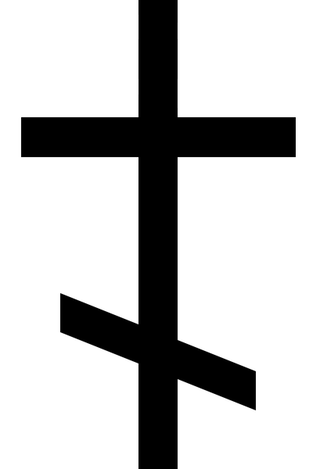
The Russian cross is a variation of the Christian cross with two crossbeams, of which the higher one is horizontal and longer, and the lower one is diagonal.
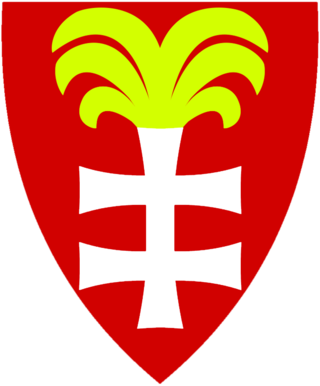
The Bebek family is the name of an ancient Hungarian noble family. The history of this family is connected with the areas in present-day Slovakia, notably in Gemer region, where they had their dominion.






